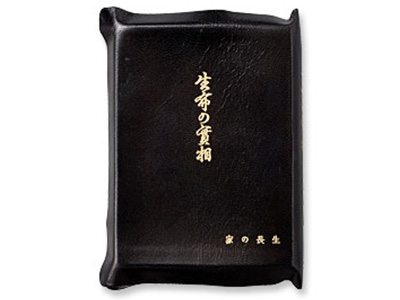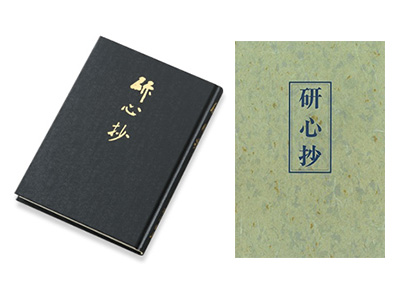Kazuo Inamori Studies
The Origins of Inamori’s Ideas
Here, you'll find an introduction to a few of the books that greatly influenced Inamori's philosophy of life and work.
Truth of Life (Language:Japanese)

| Title | Truth of Life |
|---|---|
| Author | Masaharu Taniguchi |
| Publisher | Nippon Kyobunsha |
| Year of Publication | 1932 (reprinted in 1982) |
| Format | ISO A6 (105 × 148 mm), 1,026 pages |
Description
In March 1945, when Inamori was 13 years old, he developed early symptoms of tuberculosis. At that time, tuberculosis was a deadly, incurable disease, and Inamori's uncle and aunt had both succumbed to the illness.
As he lay sick in bed, a lady living next door handed a book over the fence, saying, "He should try reading this." That book was Truth of Life, written by Masaharu Taniguchi.
Preparing for death, through the mind of a child, Inamori read with desperate concentration. In the book was a single line that stood out: "There is a magnet within our minds that attracts everything from our surroundings, be it a sword, a pistol, a disaster, an illness, or unemployment." Inamori took notice of this. He remembered constantly trying to distance himself when other family members had suffered from tuberculosis, and concluded that his own weak mind had invited the disease.
He was deeply shocked to learn that what he envisioned in his mind could manifest itself as a real phenomenon.
This encounter with the book provided a life-changing opportunity for Inamori to realize "how important the state of one's mind is to human beings."
Nanshu-o Ikun (Teachings of the Late Nanshu) (Language:Japanese)

| Title | Nanshu-o Ikun (Teachings of the Late Nanshu) |
|---|---|
| Author | Takamori Saigo |
| Publisher | Shonai Nanshukai |
Description
Among the books that had significant impact on Inamori's life and management philosophy is Nanshu-o Ikun (Teachings of the Late Nanshu).
For Inamori, who was born in Kagoshima, Takamori (Nanshu) Saigo was a legendary figure, someone he had known about for as long as he could remember. Through regional commemorations honoring Saigo, and from his own parents' teachings, Inamori was exposed to Saigo's character and philosophy from early childhood. For Inamori, Nanshu was a mentor who represented the ideals of how to think and live as a human being.
A copy of Nanshu-o Ikun bound in the old Japanese style was always on Inamori's desk. In its 41 lessons, the book contains principles that leaders should embody, discussed through stories about politics, diplomacy, and military affairs. Its teachings summarize the lives and thoughts of great individuals, conveying profound emotions and implications.
Inamori frequently quoted Nanshu-o Ikun in his lectures and on other occasions. He often referred to Saigo's struggles in life, and shared personal interpretations of Saigo's teachings in his own book, The Royal Road of Life: Lessons from Nanshu Saigo.
Unmei to Ritsumei (Fate and Establishing One's Destiny) (Language:Japanese)

| Title | Unmei to Ritsumei (Fate and Establishing One's Destiny) |
|---|---|
| Author | Masahiro Yasuoka |
| Publisher | Kansai Shiyukyokai (Revised Edition by Chichi Publishing Co.) |
| Year of Publication | 1978 (Revised Edition :1993) |
| Format |
JIS B6 (128 × 182 mm), 221 pages (First Edition) JIS B6 (128 × 182 mm), 232 pages (Revised Edition) |
| ISBN | 9784884741815 |
Description
Masahiro Yasuoka's book had a significant impact on Inamori, who contemplated the meaning of life and the human condition deeply.
"Every man has his destiny, but it need not be his fate. By doing good deeds, one's destiny can be changed."
After reading Yasuoka's book, Unmei to Ritsumei (Fate and Establishing One's Destiny), Inamori was deeply moved by this teaching and decided to lead a life embodying it.
Also, as his company grew into a highly profitable enterprise, Inamori revisited Yasuoka's teachings on the virtue of humility, prompting deep introspection on whether he was becoming complacent as a manager.
In 1976, Inamori included "Remain humble and work hard" in Kyocera's annual management slogan, partly as a reminder to himself.
Subsequently, wanting to convey this truth of life to others, he organized a public forum titled "What Is the Purpose of Life?" and continued to communicate the Law of Cause & Effect introduced in Unmei to Ritsumei.
Kenshinsho (Language: Japanese)

| Title | Kenshinsho |
|---|---|
| Author | Tempu Nakamura |
| Publisher | Tempu Society |
| Year of Publication | 1948 (First Edition) |
| Format | JIS B6 (128 × 182 mm), 315 pages |
| ISBN | 9784902579017 |
Description
Tempu Nakamura was one of the major influences on Inamori's thinking. After becoming an entrepreneur at an early age, Inamori encountered Nakamura's works and reportedly "devoured" them.
What impressed Inamori was Nakamura's teachings on "state of mind." This influenced Inamori to believe that one's life may change profoundly depending upon one's frame of mind. In other words, fortifying one's mind is the greatest challenge in life.
A passage from Kenshinsho states, "The success of a new plan lies solely in a persistent and indomitable mind. Therefore, think single-mindedly, nobly, and boldly." Inamori used this as Kyocera's management slogan for fiscal year 1982. Also, when restructuring Japan Airlines, beginning in 2010, he shared this as a slogan to unify the minds of all employees towards achieving their goals.